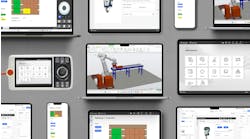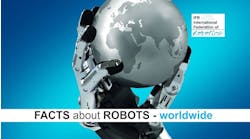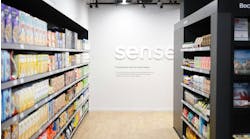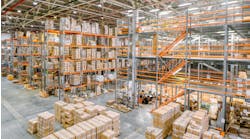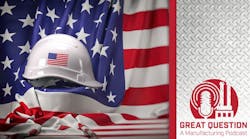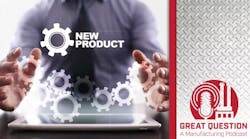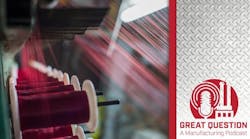Latest from Industry Trends
Podcast: Achieving Automation With "Made in America"
Modern automation comes with challenges and opportunities. On one hand, it promises to reduce or outright eliminate downtime, and on the other, it can drive up expenses trying to outfit an entire plant with new tech. In this episode of Great Question: A Manufacturing Podcast, Shalab “Shalli” Kumar, founder and chairman of EZAutomation explores the evolving landscape of industrial automation, sharing his extensive experience in the field and his mission to provide the industry with automation products and components that combine affordability and high quality while proudly being manufactured in America.
Below is an excerpt from the transcript:
Laura Davis: Welcome back to Great Question: A Manufacturing Podcast. I'm Laura Davis, editor-in-chief of New Equipment Digest. With me today is Shalli Kumar, founder and chairman of EZAutomation and its parent company, AVG Advanced Technologies, which is about to be celebrating its 50th anniversary this year. Welcome Shalli and congratulations on the success you've had in the automation industry.
Shalli Kumar: Thank you, Laura, for the warm welcome. Right off the bat, I want to thank NED and your subscribers for giving me a great start in business in 1975, when I founded AVG. There's a story behind this. I had invented the programmable limit switch, named it as PLS at that time, and I had carried it to a trade show in McCormick Place in Chicago. I did not have the funds to have a booth at the show, so I was just carrying it in my hands to see if I could get the attention of any visitors. Luckily for me, it caught the attention of the then-chief editor of NED. He got fascinated with the concept and put it on NED's front cover. We still carry that front cover in our lobbies. I got my first 100 orders from this front cover itself. At that time, these orders were good enough to sustain AVG for six months. Since then we have acquired many companies, invented a lot of new products, and by now we have an installed base of over $2 billion worldwide.
Laura Davis: That's amazing. I did not know that, PLS getting on the front cover of NED. That's really cool. The magazines have been around for a long time, and there's always, with that length of time, stuff that I still don't know. And I've been working on the brand for almost 10 years, so that's really cool. Speaking of all the orders you got and all the success you got from that as well, you know, I read that AVG has a long history of securing many patents for new equipment, innovative equipment, you know demonstrating that consistent drive to create and develop new products and solutions that you know enhance productivity and convenience for its customers. Can you share some examples of these patented technologies and discuss how this culture of innovation influences the development of the products?
Shalli Kumar: Sure. We can start with the PLS itself. I'm driven by finding solutions to problems. When back in 1974, in a Fisher body, General Motors stamping plant, I saw how the press set up guys set up timing of a press after a die change over, I said to myself "there has to be a better way to do it."
One guy is on the top of the press where the rotary cam limit switch is mounted, and the other one is down at the press bed. The guy at the press bed says: turn the cam clockwise on the feed and the guy at the top rotates the cam. And the press bed guy says it is a little too much, back it off of it. This way they go back and forth and back and forth for each cam. There are 8 cams. One cam affects the timing of the other cam. It took these two guys two shifts to finally set up all the cams.
This is when and where the PLS was born.
Today this whole setup is done in less than 5 minutes. From EZAutomation's standpoint, it is the same drive to improve plant productivity, reduce downtime, and decrease cost. In 1991, we were the first one to introduce the concept of a graphical human machine interface. Learning from my PLS experience, their fine tuning in motion was critical. We came up with the concept of dual memory in the HMI to be able to make a screen change in fraction of a second without shutting down the machine at all. This is not just the changing of the screen itself, but the screen design itself.
This is a patented feature in all our HMIs. I myself head the design team, even today, and I have over 20 patents. In 2005, we introduced the concept of an HMI integrated with a PLC programmed by the same single software. We made our programming software so simple that even a CEO can do a design of a fairly complex screen in less than 10 minutes. Unlike our competition, nobody needs to attend any school to learn how to program our products. Programming software itself has many patented features like a visibility tag for objects to save space on the screen, allowing a smaller, less expensive HMI to do the same job.
We recognize that many OEMs or system integrators do not want to share their intellectual property—that is the HMI screen design itself—particularly with these visibility tags, with their customers, the end users. So we came up with OEM utility that allows the HMI to be reprogrammed in the field with an exec. file sent over e-mail without the need for programming software.
I can talk about my inventions and patents for hours, but we don't have that much time.
About the Podcast
Great Question: A Manufacturing Podcast offers news and information for the people who make, store and move things and those who manage and maintain the facilities where that work gets done. Manufacturers from chemical producers to automakers to machine shops can listen for critical insights into the technologies, economic conditions and best practices that can influence how to best run facilities to reach operational excellence.
